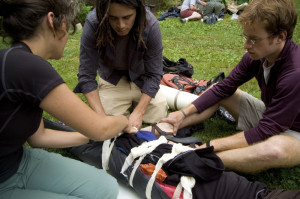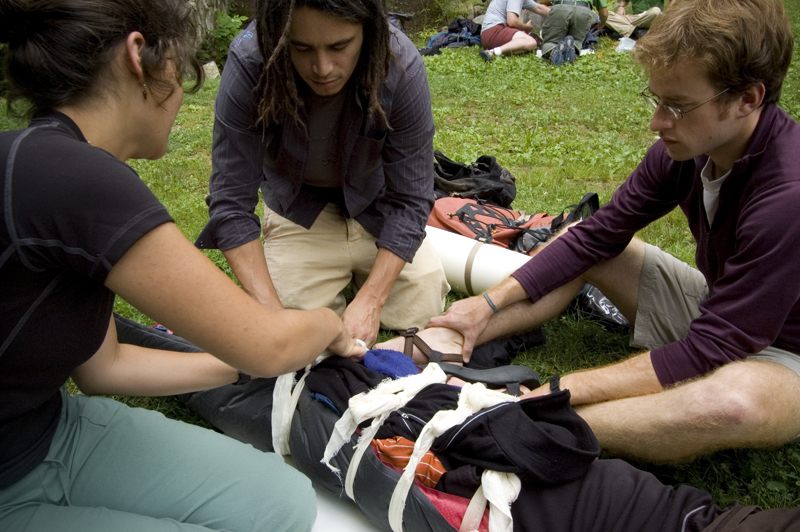Here is a video about Emergency Medical Care : How to Lift & Move Patients
[media url=”http://www.youtube.com/watch?v=gjZ6RWq21Gk” width=”600″ height=”400″]Once the extent and severity of the injury have been determined, a decision must be made regarding how to safely remove the individual from the area. The individual referred to here is usually called a casualty or the injured participant. He/ she is usually transported by qualified individuals with sufficient first aid training and background. Possible methods include ambulatory assistance, manual conveyance, and transport by a stretcher or spine board.
As a general rule, an injured individual or casualty may walk off the field or site of injury if it is determined that the injury is minor and no further harm will occur if the individual is ambulatory. If the injury is more serious, however, the individual should be non–weight bearing. Manual conveyance or removal by a spine board, stretcher, or chair may be necessary to avoid any additional pain or injury to the individual/ casualty. What to know more about standard childcare first aid re-certification?

First is ambulatory assistance. It is used to aid an injured individual who is able to walk. This implies that the injury is minor and no further harm will occur if the individual is ambulatory. In performing this technique, two individuals of equal or near-equal height should support both sides of the individual. The injured individual drapes his or her arms across the shoulders of the assistants while the arms of the assistants encircle the injured person’s back. This position enables the assistants to escort the individual to an appropriate area for further evaluation and treatment.
Second is manual conveyance. If the individual is unable to walk or the distance is too great to walk, manual conveyance should be used. The individual continues to drape his or her arms across the assistants’ shoulders while one arm of each assistant is placed behind the individual’s back and the other arm is placed under the individual’s thigh. Both assistants lift the legs up, placing the individual in a seated position. The individual is then carried to an appropriate area. Again, it is essential that the injury be fully evaluated before moving the individual in this manner.
Third is transport by spine board. In the absence of a suspected spinal injury, the safest method to move an individual is with a spine board or stretcher. Ideally, five or six individuals should roll, lift, and carry an injured person. The captain (i.e., the individual with medical seniority) stabilizes the head and gives commands for each person to slowly lift and place the injured individual onto the stretcher. The individual is then secured onto the stretcher. On command, the stretcher is raised to waist level. The individual should be carried feet first so that the captain can constantly monitor the individual’s condition. Childcare faqs will give you more ideas about childcare first aid.
In some cases, pool extrication is a possible method. Serious injuries also can occur in a swimming pool environment. If a head or neck injury is suspected, the individual must be placed on a spine board before being removed from the water. Although the principles are the same, carrying out the tasks in water requires practice.
References:
Klossner D, ed. NCAA Sports Medicine Handbook: 2005–06. Indianapolis: National Collegiate Athletic Association, 2005.
http://downloads.lww.com/wolterskluwer_vitalstream_com/sample-content/9780781784450_Anderson/samples/98853.Ch5.pdf

